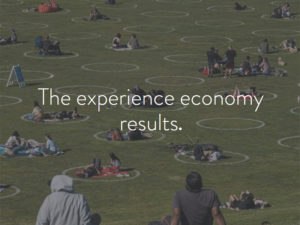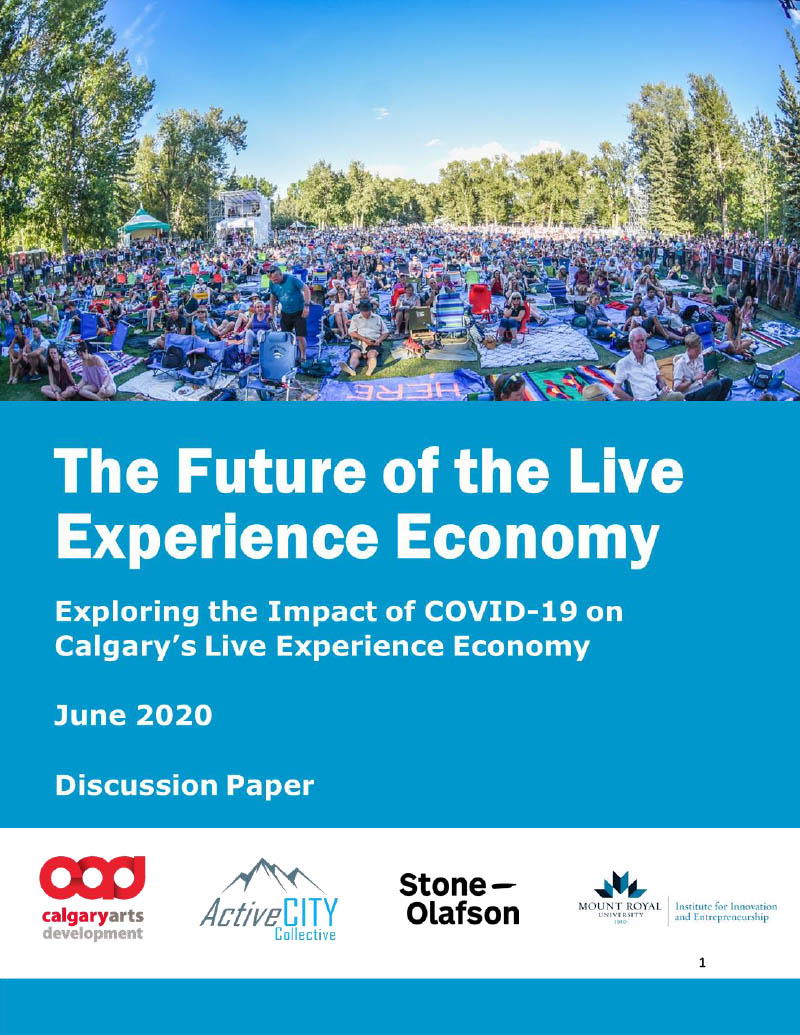Future of Calgary’s Live Experience Economy
Stone-Olafson
Originally published on June 25, 2020
Updated on August 24 & November 20, 2020; January 29, April 22 & July 21, 2021
Community organizations in the arts, culture, sports, recreation, tourism and hospitality sectors, which all rely on live group experiences, are grappling with a new reality in the wake of COVID-19.
If you are in the business of bringing people together for any reason, you need good information to help you make decisions about future events and strategies for attracting audience members.
Stone-Olafson, in collaboration with community partners, is conducting a longitudinal study with Albertan audiences to deliver reliable and relevant data about expectations and attitudes.
The New Experience Economy
Stone-Olafson is supporting experience-based organizations with timely research about how audiences will engage in a post-pandemic environment. This research is being conducted in multiple waves, with the first wave of results based on surveys conducted between May 21 and June 2, 2020. The second wave of results was released in August 2020 followed by the third wave in November 2020, fourth wave in January 2021, fifth wave in April 2021, and a sixth wave in July 2021.
The research moved into a new phase in Fall 2021. Building Experiences in the New Economy continues to build on previous efforts and allow leaders to have continued access to data to fuel recovery and inform efforts to rebuild experiences in the ways that align with changing audience expectations and needs.
The initiative is being funded by leaders who see an opportunity to support organizations that bring remarkable experiences to life in communities across Alberta. These include Calgary Arts Development, Alberta Foundation for the Arts, Edmonton Arts Council, Edmonton Community Foundation, Calgary Foundation, Rozsa Foundation, ATB, Stone-Olafson, ActiveCITY Collective, Travel Alberta, and Angus Reid.
Thanks to their generous support, there will be free access to research outcomes, workshops and sharing events to help you put the research to work for your teams.
If you have not done so already, sign up at stone-olafson.com to receive notifications about information sharing workshops and when future reports become available.
Exploring the Impact of COVID-19 on Calgary’s Live Experience Economy
The spread of COVID-19 resulted in the closing of all non-essential organizations. One of the hardest hit sectors was the collocated live experience economy. Collocated live experiences are those sectors where a minimum of 50% of products or services revenue is dependent on both the live experience producer and their customers being collocated in the same physical space. The collocated live experience economy incorporates nine sectors, including organized sport, active recreation, arts and culture, food services, retail and personal care services. In pre-COVID-19 Calgary, this included almost 15,000 organizations employing 152,000 people.
The consequences of COVID-19 mitigation measures have been not only the forced closure of many collocated live experiences, but also the explosion of innovations, as organizations sought to engage their customers through alternative means. At a global level, examples of innovations include Michelin Star restaurants offering food delivery, museums providing robotic tours, NASCAR hosting virtual races with their drivers, and musicians live streaming concerts.
There remains a fundamental question of whether entire sectors of our city have pathways to sustainability. The many innovations sparked by the COVID-19 pandemic also triggered a strategic reorientation for these organizations. Those who can develop innovations that are authentic and still generate revenue may then be in a position to further leverage these innovations for sustained growth. The discussion paper considers three questions:
- Can innovative business models developed, tested, and implemented during the pandemic trigger a structural change in live experiences?
- Will these innovations offer comparative, superior, or inferior value to customers?
- Can a more stable and sustained live experience business model be developed?
In this paper, we examine the factors that influence a customer’s decision to adopt or reject innovations in live experiences and the impact this will have on the financial sustainability of specific sectors. No LX producer could have prepared for the unprecedented impact of a global pandemic. Nor could they have anticipated the devastation that COVID-19 would have on the CLX industry. However, these same entrepreneurs and small business owners do control the decisions that will influence their future.
To support these organizations, we provide a diagnostic framework for live experience organizations to evaluate their future. Finally, we use this framework to map a series of potential innovation pathways for diverse sub-sectors of the live experience economy, from film festivals, to fitness centres, to restaurants and retail.

